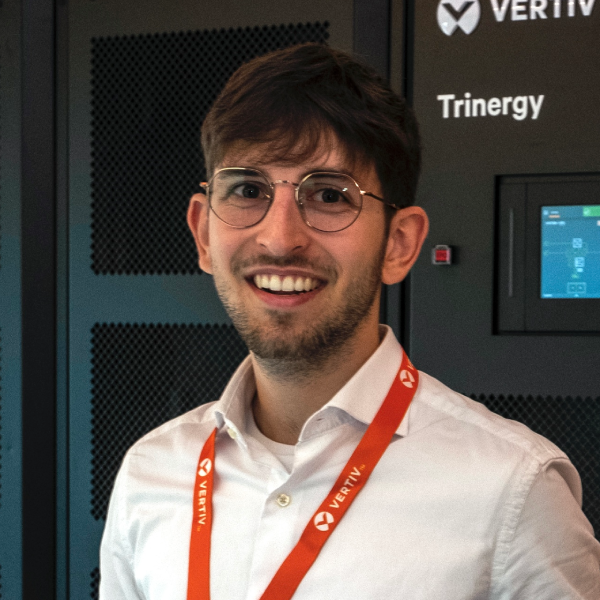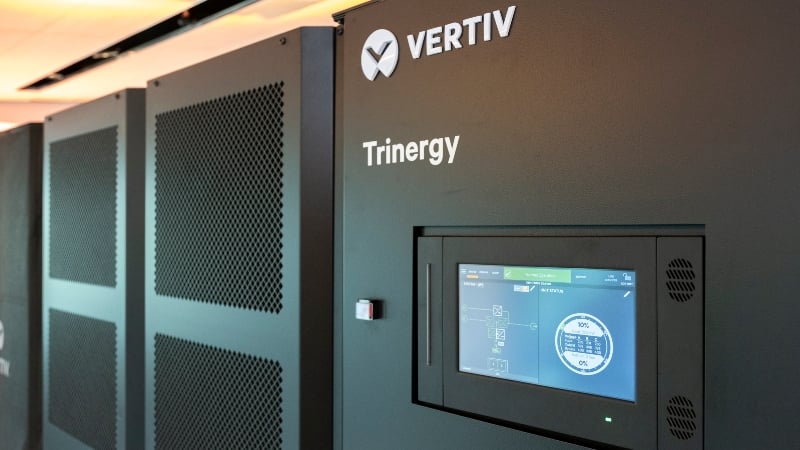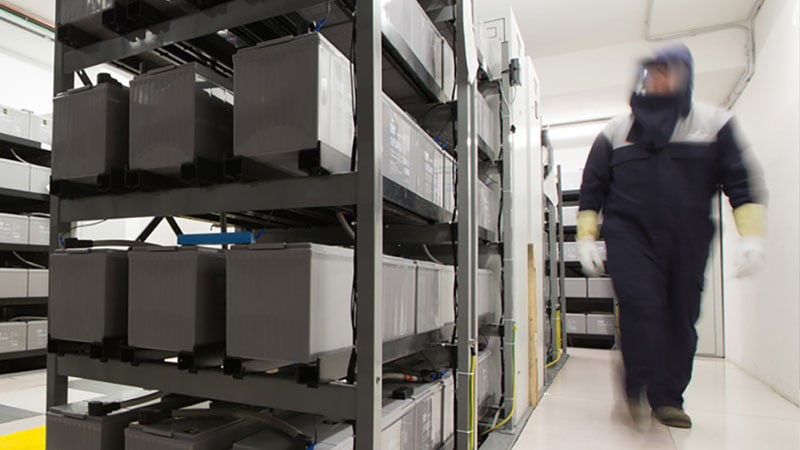High-density AI workloads introduce fast, variable power demands. Our testing evaluated how Vertiv UPS systems respond under these conditions.
AI load profiles: Dynamic, cyclical, and demanding
Unlike traditional workloads, AI workloads leveraging modern GPUs exhibit highly dynamic and cyclical load profiles. Instead of maintaining a steady power draw, AI systems frequently shift between states of low activity and sudden peaks of maximum compute. These fluctuations can occur every few seconds or even milliseconds, with loads jumping from idle (around 10%) to full capacity (100–150%) almost instantaneously.
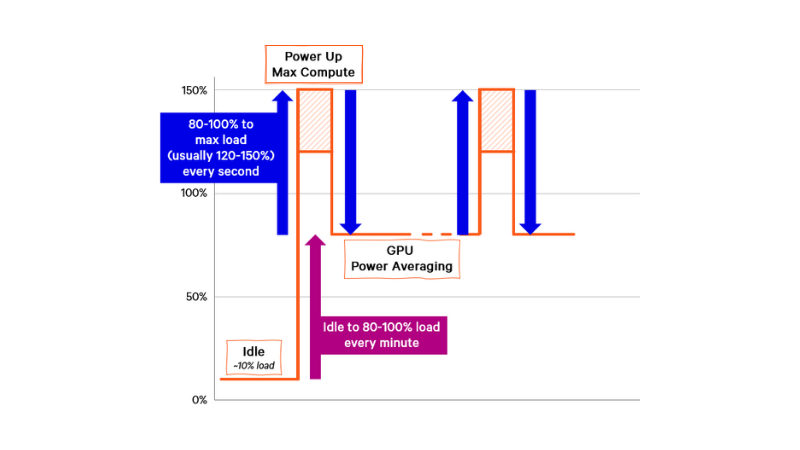
The diagram illustrates a representative AI load pattern. Here, we observe cycles where the system rapidly powers up to maximum compute levels, often exceeding 100% nominal load, then quickly drops to a lower averaged GPU power state. This behavior repeats frequently, creating power patterns that are both sharp and regular. Such patterns challenge the responsiveness of traditional power infrastructure, making it essential to design UPS and power distribution systems that can sustain rapid load transitions without degradation in performance or reliability.
Impact on power train
The dynamic and cyclic nature of AI load profiles places significant pressure on the entire power train. Frequent and abrupt power fluctuations lead to intensified thermal cycling across all power distribution components, accelerating wear and potentially reducing system lifespan. Key infrastructure elements – such as switchboards, busways, distribution panels, PDUs, static transfer switches (STS), and UPS systems – are repeatedly subjected to rapid changes in load, which increases electrical and thermal stress, and challenges their ability to maintain stability and efficiency.
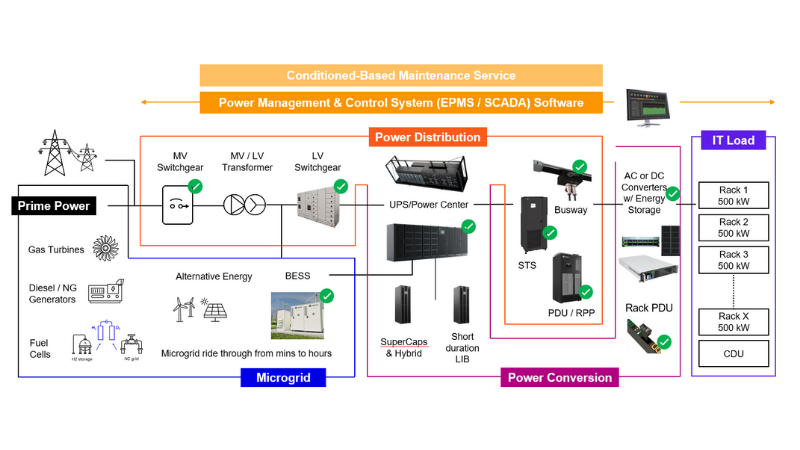
If these fast load transitions are not properly filtered or mitigated, the resulting oscillations can propagate upstream toward the main utility connection. In large-scale data centers operating at multi-megawatt levels, this can cause the grid to experience sudden and repeated spikes in demand. This instability can disrupt the grid’s balance and create power quality issues, potentially affecting not only the data center itself but also the surrounding network infrastructure.
On the generator side, these rapid load peaks may exceed the generator’s ability to respond within acceptable limits. In extreme cases, the generator may reject the load entirely, resulting in the disconnection of critical systems from their backup power source. This exposes the facility to significant risk, particularly during utility outages or grid disturbances, when reliable backup power is essential.
Why UPS is a key component to address AI’s impact
Within the entire power train, UPS stands out active component capable of effectively mitigating the challenges introduced by AI workloads. Unlike passive distribution elements – such as switchboards, PDUs, or busways – the UPS incorporates power converters that continuously regulate and convert electrical energy. This enables it to act as a filter between the fluctuating AI load and the upstream infrastructure.
By actively managing the energy flow, UPS can smooth out sharp load transitions and act as a filter, absorbing or reshaping the load profile before it reaches critical elements like the mains supply or the battery system. A properly configured UPS system enables AI factories to contain the impact of AI load dynamics, protecting the stability of the power infrastructure and delivering continuous, clean, and predictable power.
AI Load Simulator: A patented innovation for AI-ready power validation
Data center operators need a way to accurately test AI load behavior and validate their power infrastructure before deployment. Without this validation, operators risk performance degradation, unplanned downtime, and costly overengineering.
Recognizing this need, Vertiv has developed the AI Load Simulator, a patented test system designed to accurately replicate the electrical behavior of AI-driven compute loads – specifically, the fast-switching and irregular power profiles of GPU clusters operating under training or inference cycles. This system enables engineering teams to perform deterministic, repeatable testing of UPS units, PDUs, and complete power distribution architectures under realistic AI conditions.
The AI Load Simulator allows for both predefined and fully configurable load profiles, reproducing typical AI power patterns. These profiles can also incorporate actual load curves provided by GPU manufacturers, allowing for highly realistic and representative testing conditions.
Two simulation modes are available: the first version supports 2-step load profiles and application-specific curves, while the second version extends functionality to 3-step profiles, enabling more granular and complex test scenarios. The system is designed to operate at different power levels, from single rack testing to full-scale infrastructure validation, and supports both AC and DC configurations.
The AI Load Simulator includes advanced monitoring and analytics capabilities, delivering real-time insights and detailed reports on how the infrastructure responds to sudden, fluctuating power demands. These insights are critical for optimizing design, supporting R&D, and tailoring customer-specific demonstrations.
First deployed at Vertiv’s Global Power Customer Experience Center in Bologna, the AI Load Simulator is now being extended globally as a critical tool to validate infrastructure readiness for AI workloads. It enables proactive stress testing and tuning of power architectures to meet the real-world requirements of modern AI clusters – mitigating risk, reducing overengineering, and enhancing system robustness.
UPS performance standards: Testing with AI load simulator
This chapter summarizes the results of performance tests conducted on Vertiv Large Power UPS systems when subjected to simulated Artificial Intelligence (AI) load patterns. The primary objective was to evaluate the UPS’s ability to maintain a stable and uninterrupted output under dynamic and repetitive load conditions typical of AI workloads, using utility as the power source.
The tests included monitoring and analysis of key UPS parameters: input and output voltage, current, frequency, and DC bus behavior. Special attention was given to the UPS’s response to the rapid transitions between compute and idle phases, as seen during AI training and inference cycles.
The first round of tests was executed using the AI Load Simulator Rev.1, capable of generating step load variations with configurable ON/OFF timing. These initial tests aimed to verify that standard UPS firmware could support fast and repeated transitions without relying on batteries.
UPS units under test:
All tests were performed with the UPS operating in double conversion mode.
The aim is to verify that system output stability and overall performance remain unaffected during continuous operation, as IEC 62040-3 stipulates this requirement solely as a one-time test.
Scenario 1: Load steps from 0–50% up to 0–100%
Load profile description: This test represents a high-frequency, high-stress condition due to the fast power cycling (100ms ON / 30ms OFF), which imposes thermal stress (ΔT) on rectifier and inverter semiconductors.
Test duration: 4 hours
Load profile: 100ms ON, 30ms OFF (8.3 Hz)
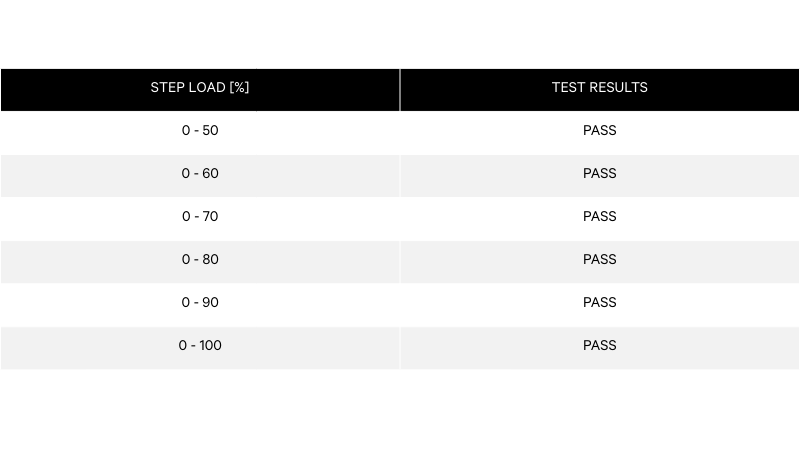
Scenario 1, load profile graphic overview.
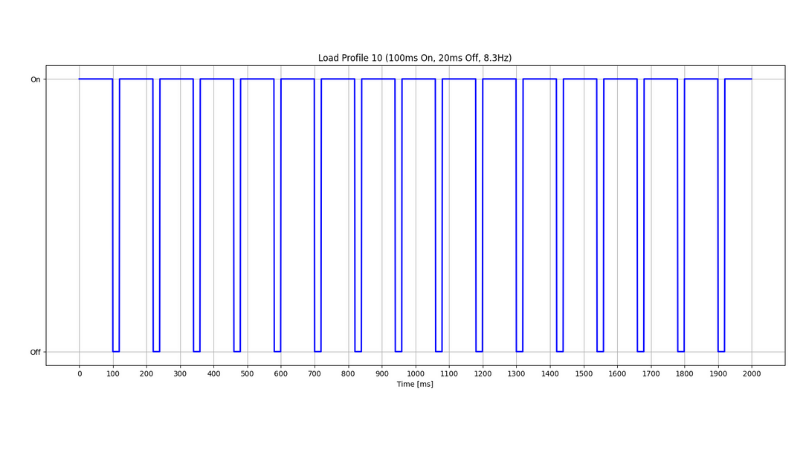
Scenario 1, Input/Output/DC bus/Batteries Waveforms
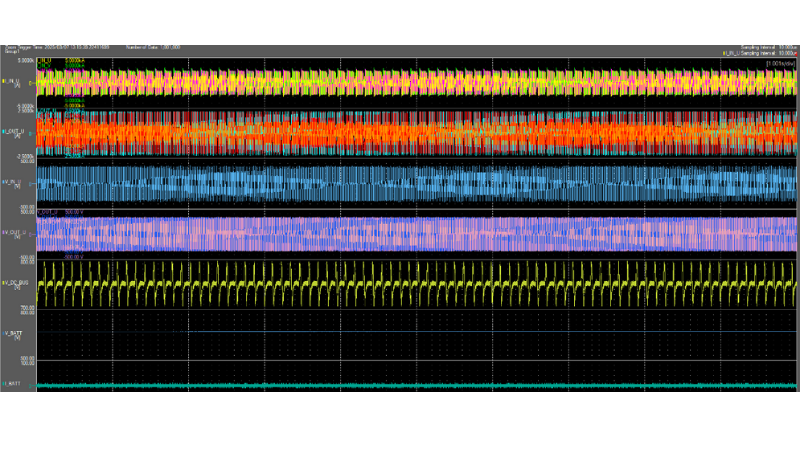
Scenario 2: Load steps from 30–50% up to 30–100%
Load profile description: This profile simulates a more stable cycling behavior (500ms ON / 500ms OFF), allowing the DC bus to reach a steady state between transitions.
Test duration: 4 hours
Load profile: 500ms ON, 500ms OFF (1 Hz)

Scenario 2, load profile graphic overview.
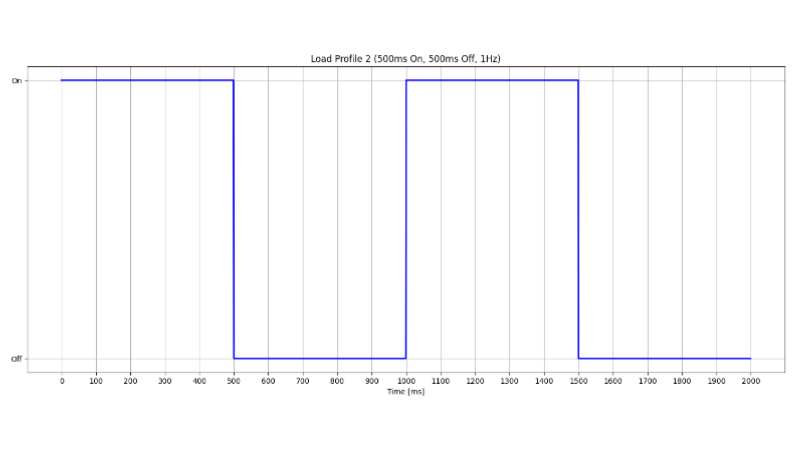
Scenario 3: Load steps from 30–50% up to 30–100%
Load profile description: The 100ms ON and 900ms OFF intend to replicate a condition for further testing the DC bus of the system when it reaches steady state condition before the next output load variation. In this case, a longer OFF period of 900ms was considered enough to test how the long term AI cycling would affect the UPS control IN & OUT from normal operation.
Test duration: 4 hours
Load profile: 100ms ON, 900ms OFF (1 Hz)
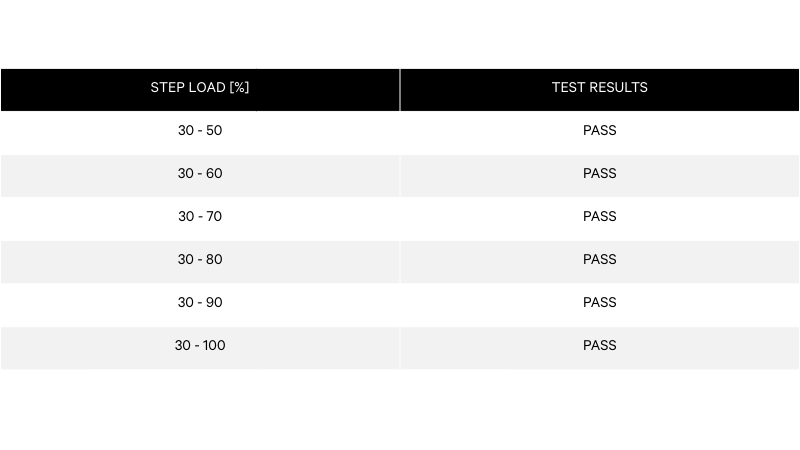
Scenario 3, load profile graphic overview.
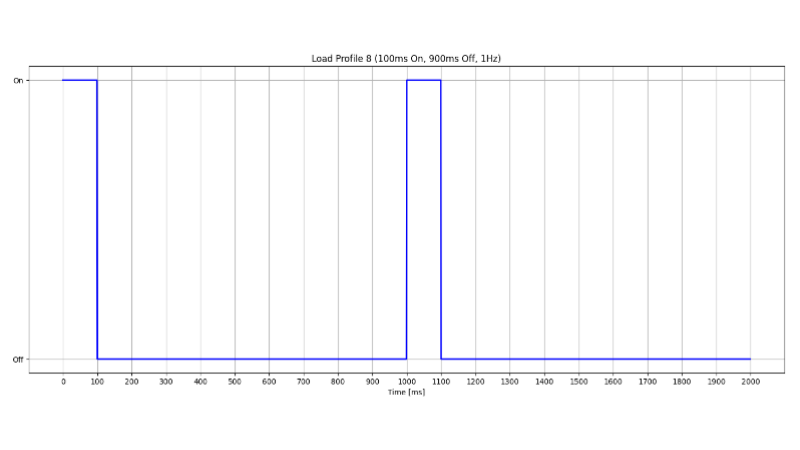
Scenario 3, Input/Output/DC bus/Batteries Waveforms
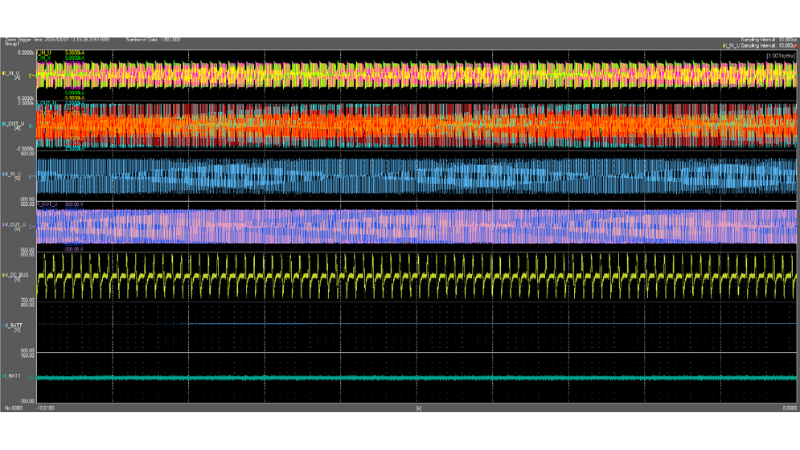
Findings and conclusion: Field-tested UPS systems for AI demands
The tests confirmed that Vertiv Large Power UPS systems (Vertiv EXL S1, Vertiv Trinergy and Vertiv PowerUPS 9000) are capable of handling highly dynamic AI load steps from 0% to 100% of their rated capacity without involving the battery, provided the utility source remains within nominal parameters. This demonstrates the resilience of UPS design and their suitability for AI workloads characterized by rapid and frequent load fluctuations, this has also been field proven in different datacenter sites, like the EdgeConneX site where Vertiv EXL S1 works with AI variable loads.
Looking forward, Vertiv continues to work on firmware-based features aimed at further enhancing system performance and battery protection during more demanding conditions, such as overload transients and complex AI load profiles that temporarily exceed 100% nominal load. These improvements are designed to reduce battery stress and extend battery life with a larger set of load profiles.


